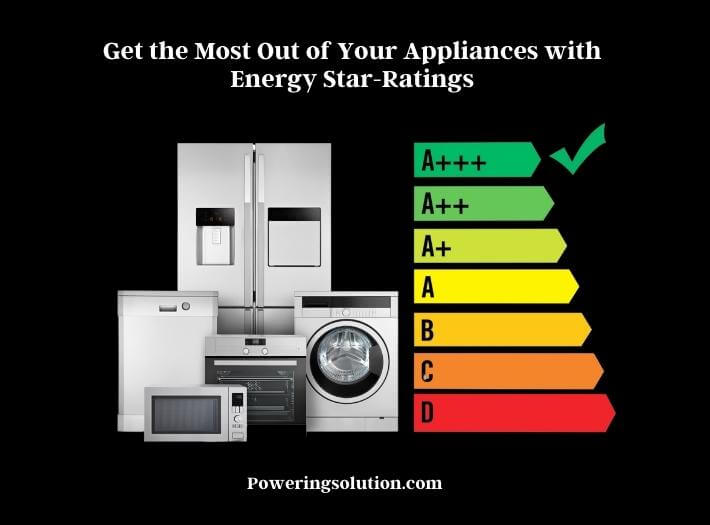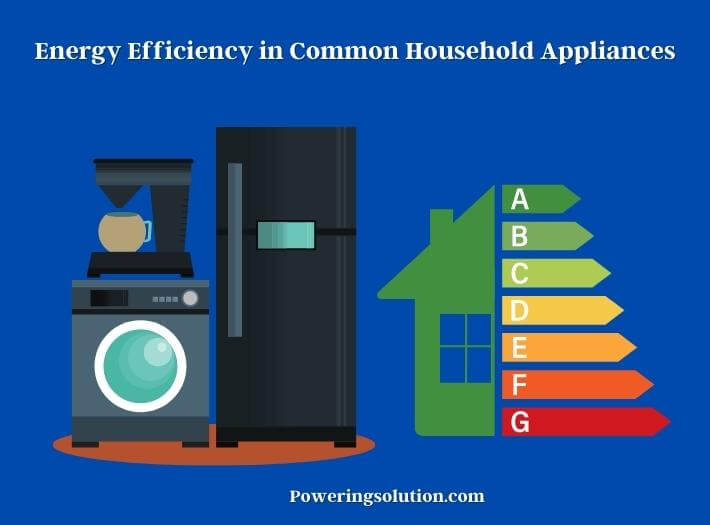Energy consumption is a major concern for many households around the world, as utility bills continue to rise year after year. With more and more people looking for ways to reduce their energy usage and lower their monthly bills, the need for energy-efficient appliances has never been greater.

One of the most popular ways to identify energy-efficient products is through Energy Star ratings, a program created by the U.S. Environmental Protection Agency (EPA) to help consumers identify products that meet certain energy efficiency guidelines.
What are Energy Star ratings?
Energy Star ratings are a program created by the U.S. Environmental Protection Agency (EPA) to help consumers identify products that meet certain energy efficiency guidelines. Products that earn an Energy Star rating have been independently certified to be energy-efficient and use less energy than their standard counterparts, without sacrificing performance or features.
These ratings are available for a wide range of products, including appliances, electronics, lighting, and HVAC systems. By choosing Energy Star-rated products, consumers can save money on their utility bills and reduce their overall energy consumption, while still enjoying high-quality products that perform just as well as traditional products.
How do Energy Star Ratings Work?
Energy Star ratings are based on a number of factors, including energy efficiency, performance, and features. To earn an Energy Star rating, a product must meet certain energy efficiency guidelines, which are set by the EPA.

These guidelines are designed to ensure that the product uses less energy than traditional products while still delivering the same level of performance. Energy Star ratings are awarded on a scale of 1-100, with products that score higher on the scale being more energy-efficient.
How Can You Use Energy Star Ratings to Get the Most Out of Your Appliances?
There are a number of ways that you can use Energy Star ratings to get the most out of your appliances. Look for Energy Star labels when you’re shopping for new appliances. This will help you to identify products that are more energy-efficient and can help you save money on your monthly bills.
Consider replacing old, inefficient appliances with new Energy Star-rated models. This can help you to save even more money on your energy bills over time.
Make sure that you’re using your appliances properly. For example, don’t overfill your refrigerator or leave your oven on when you’re not using it.
Benefits of Energy Star-rated Appliances
There are a number of benefits to using Energy Star-rated appliances in your home. They can help you to save money on your monthly energy bills. Because Energy Star-rated appliances use less energy than traditional products, they can help you to reduce your energy consumption and save money on your monthly bills.
They can help you to reduce your carbon footprint. By using less energy, you’ll be reducing your impact on the environment and helping to protect the planet for future generations.
Finally, they can help you to improve the overall comfort and quality of your home. Energy Star-rated appliances are designed to perform just as well as traditional products, so you won’t have to sacrifice performance for energy savings.
Energy Efficiency in Common Household Appliances
When it comes to household appliances, there are a number of common products that can benefit greatly from Energy Star ratings. Here are some examples:

Refrigerators
Refrigerators are one of the largest energy consumers in most households, so it’s important to choose an Energy Star-rated model. These appliances use 15% less energy than standard models, which can translate to significant savings on your energy bill over time.
Dishwashers
Energy Star-rated dishwashers use less water and energy than standard models, and they’re also quieter and more efficient at cleaning your dishes.
Clothes Washers
Energy Star-rated clothes washers use 25% less energy and 45% less water than standard models, which can help you save money on your water and energy bills.
Clothes Dryers
Although there are currently no Energy Star ratings for clothes dryers, you can still choose a more energy-efficient model by looking for one with a moisture sensor. These models will automatically shut off once your clothes are dry, which can save you money on your energy bill.
Air Conditioners
Energy Star-rated air conditioners are up to 15% more efficient than standard models, which can help you stay cool during the hot summer months while also saving you money on your energy bill.
Energy Efficiency in Home Electronics
Home electronics can also benefit from Energy Star ratings, helping you to save energy and money. Here are some examples of electronics that you should consider purchasing with an Energy Star rating:
- Energy Star-rated TVs use about 25% less energy than standard models, which can lead to significant savings over time. Additionally, these TVs often have automatic brightness controls, which help to reduce energy consumption even further.
- Energy Star-rated computers use less energy than standard models, and they also have automatic sleep modes that help to conserve energy when the computer is not in use.
- Energy Star-rated audio equipment is up to 50% more efficient than standard models, which can help you save money on your energy bill.
- Battery chargers for cell phones, laptops, and other electronics can also benefit from an Energy Star rating. These chargers use less energy and are designed to automatically shut off when the battery is fully charged, which helps to conserve energy.
Understanding Energy-Saving Technologies
Energy-saving technologies can help you to reduce your energy consumption and save money on your utility bills. Here are some common technologies that you should be familiar with:
- LED lighting: LED lights are highly energy-efficient and can last up to 25 times longer than traditional incandescent bulbs. By replacing your traditional bulbs with LEDs, you can significantly reduce your energy consumption and save money on your lighting bills.
- Smart thermostats: Smart thermostats are designed to learn your heating and cooling preferences and adjust the temperature automatically to save energy. These thermostats can also be controlled remotely via a smartphone app, which can help you to save money when you’re away from home.
- Energy-efficient windows: Energy-efficient windows are designed to keep your home comfortable year-round by reducing drafts and heat loss. These windows are typically made with low-emissivity glass, which helps to reflect heat back into your home during the winter months.
- Programmable appliances: Many appliances, such as dishwashers and washing machines, are now available with programmable features that allow you to run them during off-peak hours when energy rates are lower.
- Solar panels: Solar panels can help you to generate your own energy and reduce your reliance on the grid. While the initial cost of installing solar panels can be high, you can save money on your energy bills in the long run.
Shopping for Energy Star-Certified Appliances
When shopping for household appliances, it’s important to look for products that have been certified by Energy Star. Energy Star-certified appliances are designed to meet strict energy-efficiency guidelines, helping you to save money on your energy bills while also reducing your carbon footprint.
Look for the Energy Star label on the appliance or its packaging. This label indicates that the product meets energy-efficiency standards set by the U.S. Environmental Protection Agency (EPA).
Look for the appliance’s energy rating, which is typically displayed on the product’s label. This rating will help you to compare the energy efficiency of different models and choose the one that will save you the most money in the long run.
Choose an appliance that is appropriately sized for your household’s needs. A larger appliance may use more energy than necessary, while an undersized appliance may not be able to handle your household’s demands.
Many Energy Star-certified appliances include special features that help to reduce energy consumption even further. For example, some refrigerators include automatic ice makers that reduce energy consumption, while some washing machines use sensors to determine the appropriate amount of water to use for each load.
Many utility companies offer rebates or incentives for customers who purchase Energy Star-certified appliances. Check with your local utility company to see if they offer any such programs.
Financing Options for Energy Star-Certified Appliances
Energy Star-certified appliances can be more expensive upfront than their non-certified counterparts, but they can also save you money on your energy bills in the long run. If you’re interested in purchasing an Energy Star-certified appliance but are concerned about the upfront cost.
Manufacturer Financing
Many manufacturers offer financing options for their Energy Star-certified products. These financing options may include low or no interest rates and flexible payment terms.
Energy Efficiency Loans
Some utility companies offer energy efficiency loans that can be used to finance the purchase of Energy Star-certified appliances. These loans typically have low-interest rates and long repayment terms.
Home Equity Loans
Home equity loans may also be used to finance the purchase of Energy Star-certified appliances. These loans allow you to borrow against the equity in your home and typically have low-interest rates and long repayment terms.
Rebates and Incentives
Some utility companies offer rebates or incentives for customers who purchase Energy Star-certified appliances. These rebates can help to offset the upfront cost of the appliance and make it more affordable.
Federal Tax Credits
The U.S. federal government offers tax credits for homeowners who purchase and install Energy Star-certified appliances. These tax credits can help to reduce the overall cost of the appliance.
Be sure to shop around and compare financing options to find the one that best meets your needs and budget. With the right financing, you can enjoy the energy savings and environmental benefits of Energy Star-certified appliances while also saving money upfront.
Advancements in Energy Efficiency
Advancements in energy efficiency have come a long way in recent years, with new technologies and innovations being developed to make appliances and electronics even more energy-efficient.
Smart Home Technology
Smart home technology has become increasingly popular in recent years, and it can also help to improve energy efficiency. Smart thermostats, for example, can learn your heating and cooling preferences and adjust your HVAC system accordingly, resulting in energy savings. Smart plugs can also be used to control when and how long devices are used, reducing unnecessary energy consumption.
LED Lighting
LED lighting has become the standard for energy-efficient lighting, with LED bulbs using up to 80% less energy than traditional incandescent bulbs. Not only do they use less energy, but they also last much longer, reducing the need for frequent bulb replacements.
Energy-Efficient Appliances
Energy Star-certified appliances have been around for many years, but advancements in technology have made them even more efficient. For example, refrigerators now use advanced insulation and compressors to reduce energy consumption, while dishwashers use sensors to optimize water and energy usage.
Renewable Energy
The use of renewable energy sources such as solar and wind power has become increasingly common, and advancements in these technologies have made them even more accessible and cost-effective. Homeowners can now install solar panels or wind turbines (here is the exploring the history and development of Darrieus wind turbines) to generate their own electricity, reducing reliance on fossil fuels and lowering energy costs.
In a Nutshell
Energy efficiency is an important aspect of modern living, and advancements in technology have made it easier than ever to reduce energy consumption and save money on utility bills. Energy Star-certified appliances and electronics, as well as smart home technology and renewable energy sources, are just a few of the many options available to homeowners looking to improve energy efficiency. By understanding the benefits of these technologies and taking advantage of financing options and incentives, you can make your home more energy-efficient while also saving money in the long run.
As we become more aware of the impact of our daily actions on the environment, it is crucial to make conscious decisions to reduce our carbon footprint. By choosing energy-efficient appliances and electronics and implementing energy-saving technologies in our homes, we can make a significant contribution to reducing greenhouse gas emissions and preserving our planet for future generations.
Remember to always look for the Energy Star label when shopping for appliances and electronics, and do your research to find the most energy-efficient options available. With these steps, you can get the most out of your appliances while also reducing your environmental impact and saving money on your utility bills.
